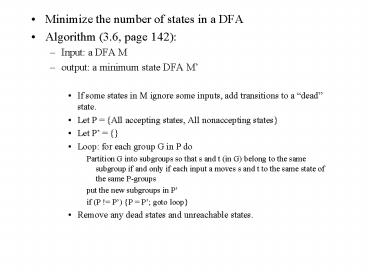Minimize the number of states in a DFA - PowerPoint PPT Presentation
Title:
Minimize the number of states in a DFA
Description:
Minimize the number of states in a DFA Algorithm (3.6, page 142): Input: a DFA M output: a minimum state DFA M If some states in M ignore some inputs, add ... – PowerPoint PPT presentation
Number of Views:62
Avg rating:3.0/5.0
Title: Minimize the number of states in a DFA
1
- Minimize the number of states in a DFA
- Algorithm (3.6, page 142)
- Input a DFA M
- output a minimum state DFA M
- If some states in M ignore some inputs, add
transitions to a dead state. - Let P All accepting states, All nonaccepting
states - Let P
- Loop for each group G in P do
- Partition G into subgroups so that s and t (in G)
belong to the same subgroup if and only if each
input a moves s and t to the same state of the
same P-groups - put the new subgroups in P
- if (P ! P) P P goto loop
- Remove any dead states and unreachable states.
2
- Example minimize the DFA for (abba)a
- Example minimize the DFA for Fig 3.29 (pages
121) - Questions How can we implement Lex?
- BEGIN return(BEGINNUMBER)
- END return(ENDNUMBER)
- IF return(IFNUMBER)
3
- Lex internal
- construct an NFA to recognize the sum of all
patterns - convert the NFA to a DFA (record all accepting
states for each individual pattern). - Minimize the DFA (separate distinct accepting
states for the initial pattern). - Simulate the DFA to termination (that is, no
further transitions) - Find the last DFA state entered that holds an
accepting NFA state (this picks the longest
match). If no such state, then it is an invalid
token.
4
Chapter 4 Syntax analysis
- Syntax analysis is done by the parser.
- Detects and reports any syntax errors.
- Produces a parse tree from which intermediate
code can be generated.
token
Rest of front end
Lexical analyzer
Int. code
Parse tree
Source program
parser
Request for token
Symbol table
5
- The syntax of a programming language is described
by a context-free grammar (Backus-Naur Form
(BNF)). - A grammar gives a precise syntactic specification
of a language. - From some classes of grammars, tools exist that
can automatically construct an efficient parser.
These tools can also detect syntactic ambiguities
and other problems automatically. - A compiler based on a grammatical description of
a language is more easily maintained and updated.
6
- A grammar G (N, T, P, S)
- N is a finite set of non-terminal symbols
- T is a finit set of terminal symbols
- P is a finit subset of
- An element is written as
- S is a distinguished symbol in N and is called
the start symbol. - Language defined by a grammar
- We say aAb derives awb in one step, denoted as
aAbgtawb, if A-gtw is a production and a and b
are arbitrary strings of terminal or nonterminal
symbols. - We say a1 derives am if a1gta2gtgtam, written as
a1gtam - The languages L(G) defined by G are the set of
strings of the terminals w such that Sgtw.
7
- Example
- A-gtaA
- A-gtbA
- A-gta
- A-gtb
8
- Chomsky Hierarchy (classification of grammars)
- A grammar is said to be
- regular if it is
- right-linear, where each production in P has the
form, or
. Here, A and B are non-terminals and w is a
terminal - left-linear
- context-free if each production in P is of the
form , where and - context sensitive if each production in P is of
the form where - unrestricted if each production in P is of the
form where
9
- Context-free grammar is sufficient to describe
most programming languages. - Example a grammar for arithmetic expressions.
- ltexprgt -gt ltexprgt ltopgt ltexprgt
- ltexprgt -gt ( ltexprgt )
- ltexprgt -gt - ltexprgt
- ltexprgt -gt id
- ltopgt -gt - /
- derive -(id) from the grammar
- ltexprgt gt -ltexprgt gt - (ltexprgt) gt-(id)
- sentence a strings of terminals that can be
derived from S - sentential form a strings of terminals or none
terminals that can be derived from S.
10
- derive id id id from the grammar
- EgtEEgtEEEgtEEidgtEididgtididid
- leftmost/rightmost derivation -- each step
replaces leftmost/rightmost non-terminal. - EgtEEgtidEgtidEEgtididEgtididid
- Parse tree
- A parse tree pictorially shows how the start
symbol of a grammar derives a specific string in
the language. Given a context-free grammar, a
parse tree has the following properties - The root is labeled by the start symbol
- Each leaf is labeled by a token or the empty
string - Each interior node is labeled by a nonterminal
- If A is a non-terminal labeling some interior
node and abcdefg..z are the labels of the
children of that node from left to right, then
A-gtabcdefg..z is a production of the grammar.
11
- The leaves of the parse tree read from left to
right is called yield of the parse tree. It is
equivalent to the string derived from the
nonterminal at the root of the parse tree. - An ambiguous grammar is one that can generate two
or more parse trees that yield the same string - E.G
- string -gt string string
- string-gtstring - string
- string -gt0123456789
- stringgtstring string gtstring - string
string gt 9 -5 2 - stringgtstring - stringgtstring - string string
gt9-52































